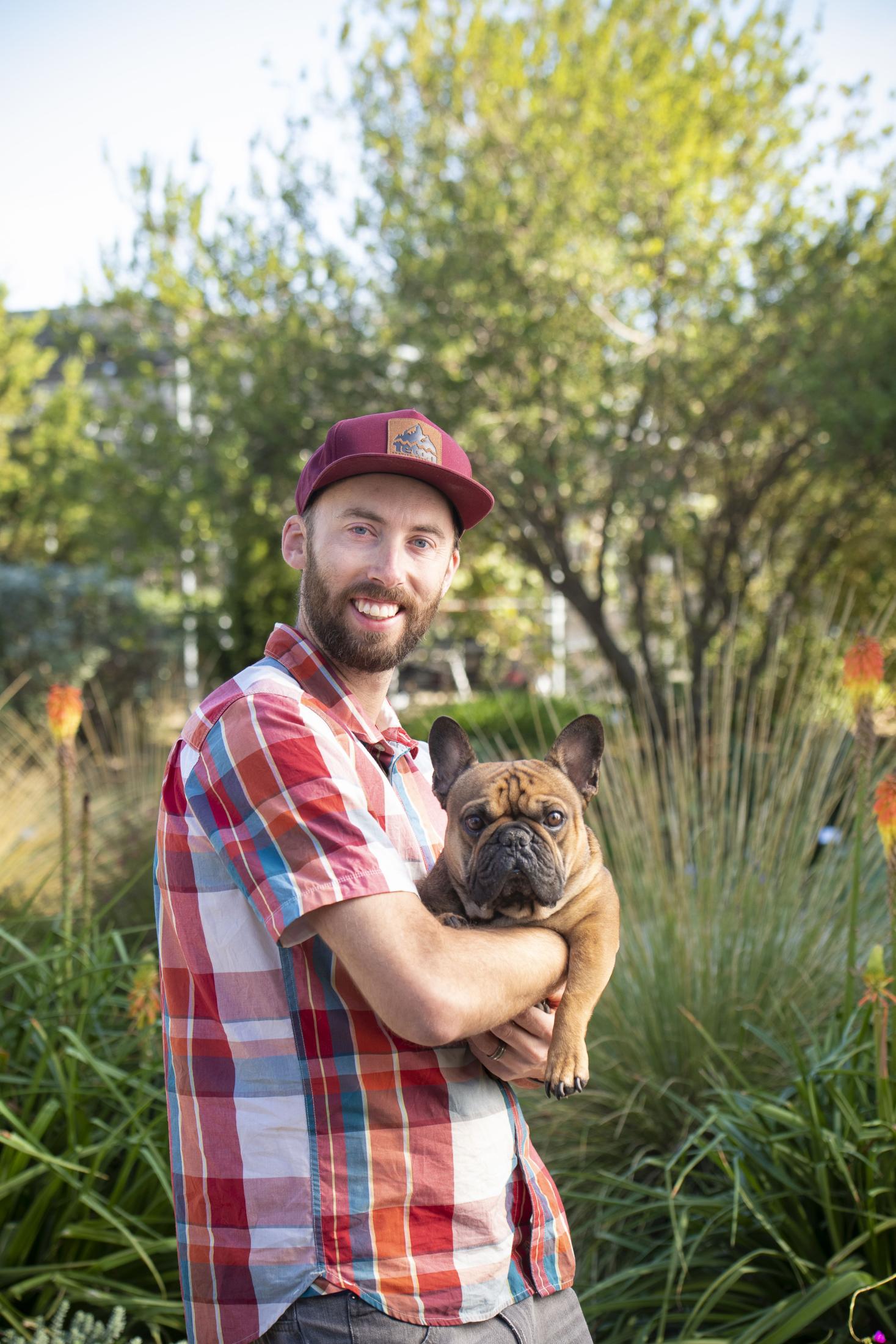Medicine to Help My Dog Walk Again
Dog possessor Rob Beasom and his wife were out of town when they received a frantic call from their canis familiaris sitter. Barley, their 3-yr-old male French bulldog, severely injure himself while jumping off the couch, rendering him paralyzed in his dorsum legs. Beasom immediately fabricated plans to render dwelling house and called Barley'due south primary veterinarian. After Beasom described the situation, the veterinarian told him to take Barley to the UC Davis veterinary hospital.
Upon Barley'southward inflow at UC Davis, critical care specialists in the Emergency Room consulted with the Neurology/Neurosurgery Service, equally Barley'due south acute paralysis certainly involved a spinal issue.

The neurologists' examination of Barley showed him to accept hurting in his lower back region, consistent with an injury affecting the spinal string in the region between the third thoracic vertebrae (upper to center back) and third lumbar vertebrae (lower back). Barley'south care team so enlisted the help of the Diagnostic Imaging Service in hopes that a CT scan would pinpoint the exact surface area of his injury. The scan did simply that, revealing a herniated disc at L3-L4 resulting in compression of the spinal cord – the cause of the paralysis. The imaging besides showed evidence of intervertebral disc illness (IVDD) which was causing degeneration at multiple disc sites.
On duty with the neurosurgeons that day was Dr. Karen Park, a 2nd-year small animal surgery resident. While surgery residents primarily spend their time with the Orthopedic Surgery and the Soft Tissue Surgery Services, they also rotate through the Neurology/Neurosurgery Service to exist trained in routine neurosurgery. Dr. Park would take the atomic number 82 on Barley's case and see him through discharge and follow-up appointments.
"I of the reasons why I wanted to become a surgeon is because the surgeries are not limited to one area; and as a surgeon, there is and then much more to a patient'due south care and possessor communication aside from the surgery itself," said Dr. Park. "There's a lot of interest in the patient care aspect to a case both before and subsequently surgery. Every bit surgeons, we are involved with both internal medicine and disquisitional intendance aspects of cases, and (as residents) we railroad train with other specialties, like neurology/neurosurgery with Barley'due south example."
Multiple specialties and specialists working together under one roof sets UC Davis apart from nigh veterinary hospitals. While many hospitals volition have a dozen or so specialty services, UC Davis has more than than xxx, making it the most comprehensive veterinarian hospital in the state. As the infirmary looks to expand and transition to the Veterinarian Medical Center (VMC) over the coming decade, those opportunities for collaboration will increase and become more than efficient. And more than animals like Barley will benefit.
Barley's care team was confident they could correct his immediate problems with surgery, but his IVDD is a degenerative disease that could continue to cause spinal cord compression issues in the time to come. IVDD affects the cartilage discs between the vertebrae, which normally act as a cushion between each vertebra. As the disc becomes mineralized or calcified over fourth dimension, the abnormal disc cloth in the center herniates, and information technology extrudes out towards the spinal cord. This results in compression, bruising, and sometimes haemorrhage around the spinal string and subsequent neurological signs, such equally Barley existence unable to movement his hind legs.
Dr. Park and neurology/neurosurgery kinesthesia member Dr. Chai-Fei Li performed a hemilaminectomy surgery that relieved the compression of Barley's spine. During the procedure, surgeons drilled/opened a "window" in the lamina portion of the vertebrae. This process preserved the structural integrity of the spinal cavalcade, but immune the surgeons admission to make clean out the disc area that herniated against the spine. Once that droppings was cleaned out, Barley's spine was no longer compressed, allowing the spinal string and nerves to his hind legs to heal and eventually function properly again.
Drs. Park and Li also performed a process called a fenestration at nearby disc spaces to remove the abnormal disc material that is at risk for future herniation. While this volition non completely prevent future disc herniation, it may reduce the take chances.
Barley recovered well from his surgery. He was mildly convalescent with good motor function in both hind limbs after 3 days of hospitalization. Dr. Park ordered strict cage rest for 4 to 6 weeks. While the majority of Barley's recovery volition occur in the first two to three months, it can have upwardly to six to nine months for the spinal cord to completely heal from an injury.
Six weeks after surgery, Barley visited Dr. Park for his follow-up engagement. She is happy to report that Barley's recovery is going well, and he tin gradually render to normal action at habitation, starting with ten-fifteen infinitesimal walks a few times a twenty-four hours. However, jumping off the couch and rough play are still off limits for several months and to be limited for the residual of his life.
Equally part of the VMC projection, UC Davis volition construct an entirely new Pocket-size Animal Clinic, expanding the size and scope of the electric current hospital. This will open new training opportunities for residents like Dr. Park, assuasive them more experience in procedures like Barley'southward surgery, and go on to push the limits of veterinary medicine.
# # #
Source: https://www.vetmed.ucdavis.edu/news/surgeons-help-acutely-paralyzed-dog-walk-again
0 Response to "Medicine to Help My Dog Walk Again"
Post a Comment